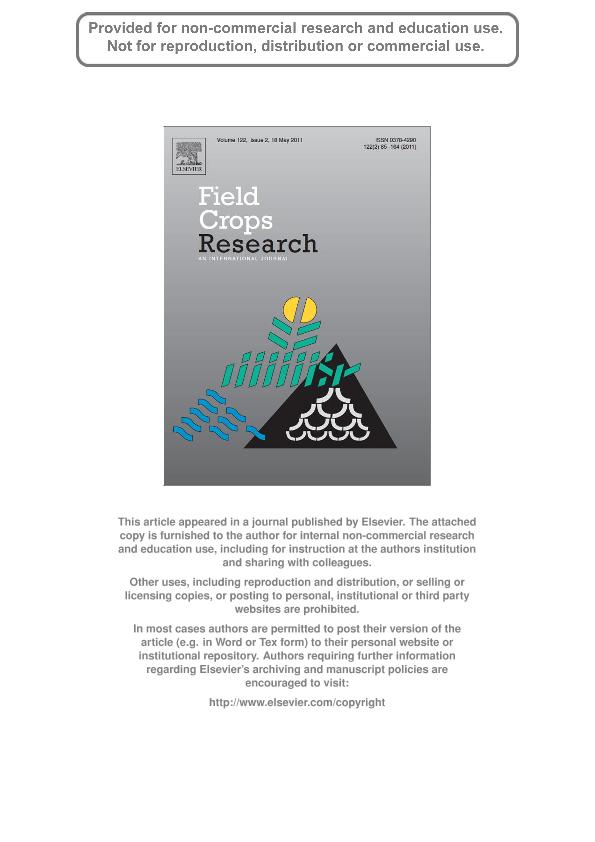Mostrar el registro sencillo del ítem
dc.contributor.author
Caviglia, Octavio Pedro

dc.contributor.author
Melchiori, Ricardo José Miguel

dc.date.available
2023-03-30T17:32:17Z
dc.date.issued
2011-05
dc.identifier.citation
Caviglia, Octavio Pedro; Melchiori, Ricardo José Miguel; Contribution of contrasting plant hierarchies to the response to N fertilizer in maize; Elsevier Science; Field Crops Research; 122; 2; 5-2011; 131-139
dc.identifier.issn
0378-4290
dc.identifier.uri
http://hdl.handle.net/11336/192184
dc.description.abstract
The typical size structuring process that occurs as a consequence of intra-specific competition in maize promotes the appearance of contrasting plant hierarchies (i.e. dominated and dominant individuals). This process may become more intense under low nitrogen (N) availability. The alleviation of plant competition by N addition may reduce plant yield variability through a differential response to N in individuals of contrasting hierarchies. In this work, the response to N of dominated and dominant plants from stands with contrasting N supply (0 to 140-200kgNha-1) was examined on 11 experiments carried out in Paraná, Argentina (31°50'S; 60°31'W) in a broad range of growing conditions that included the variation of the year, genotype, plant population and sowing date. Our objectives were: (i) to evaluate the response to N in contrasting plant hierarchies of maize, (ii) to quantify the contribution of dominated and dominant plants to the response to N of the overall stand, and (iii) to study the effect of N on relationships between plant hierarchies and stand variability. Response to N of yield per plant was associated with biomass per plant in non-fertilized controls, tending to be higher in plants with low biomass. The response to N of yield per unit area (i.e., considering all individuals of the stand) was related to the response to N of dominant and dominated plants (P<0.0001). However, at a higher level of response to N of grain yield per unit area (>50-60%), dominant plants had a considerable lower response than dominated plants, whereas at a lower level of response (<30%), the contribution of contrasting plant hierarchies was similar. In stands with similar plant biomass between hierarchies, the differences in the response to N between plant types tended to be negligible. The coefficient of variation of yield per plant was reduced (P<0.05) by effect of N in 4 out of 11 experiments, although it tended to be consistently lower in fertilized treatments. When the differences between the biomass of dominated and dominant plants were ample we found the highest response to N at the stand level, as a result of the higher increase in grain yield per plant in dominated plants than in dominant ones. The response to N in each plant hierarchy was differentially associated with increases in shoot biomass, harvest index, kernel number per plant and kernel weight.
dc.format
application/pdf
dc.language.iso
eng
dc.publisher
Elsevier Science

dc.rights
info:eu-repo/semantics/openAccess
dc.rights.uri
https://creativecommons.org/licenses/by-nc-sa/2.5/ar/
dc.subject
INTRA-SPECIFIC COMPETITION
dc.subject
MAIZE
dc.subject
NITROGEN
dc.subject
PLANT HIERARCHIES
dc.subject.classification
Agricultura

dc.subject.classification
Agricultura, Silvicultura y Pesca

dc.subject.classification
CIENCIAS AGRÍCOLAS

dc.title
Contribution of contrasting plant hierarchies to the response to N fertilizer in maize
dc.type
info:eu-repo/semantics/article
dc.type
info:ar-repo/semantics/artículo
dc.type
info:eu-repo/semantics/publishedVersion
dc.date.updated
2023-03-30T14:50:26Z
dc.journal.volume
122
dc.journal.number
2
dc.journal.pagination
131-139
dc.journal.pais
Países Bajos

dc.journal.ciudad
Amsterdam
dc.description.fil
Fil: Caviglia, Octavio Pedro. Universidad Nacional de Entre Ríos; Argentina. Instituto Nacional de Tecnología Agropecuaria; Argentina. Consejo Nacional de Investigaciones Científicas y Técnicas; Argentina
dc.description.fil
Fil: Melchiori, Ricardo José Miguel. Instituto Nacional de Tecnología Agropecuaria; Argentina
dc.journal.title
Field Crops Research

dc.relation.alternativeid
info:eu-repo/semantics/altIdentifier/url/https://www.sciencedirect.com/science/article/pii/S0378429011000931
dc.relation.alternativeid
info:eu-repo/semantics/altIdentifier/doi/http://dx.doi.org/10.1016/j.fcr.2011.03.011
Archivos asociados
